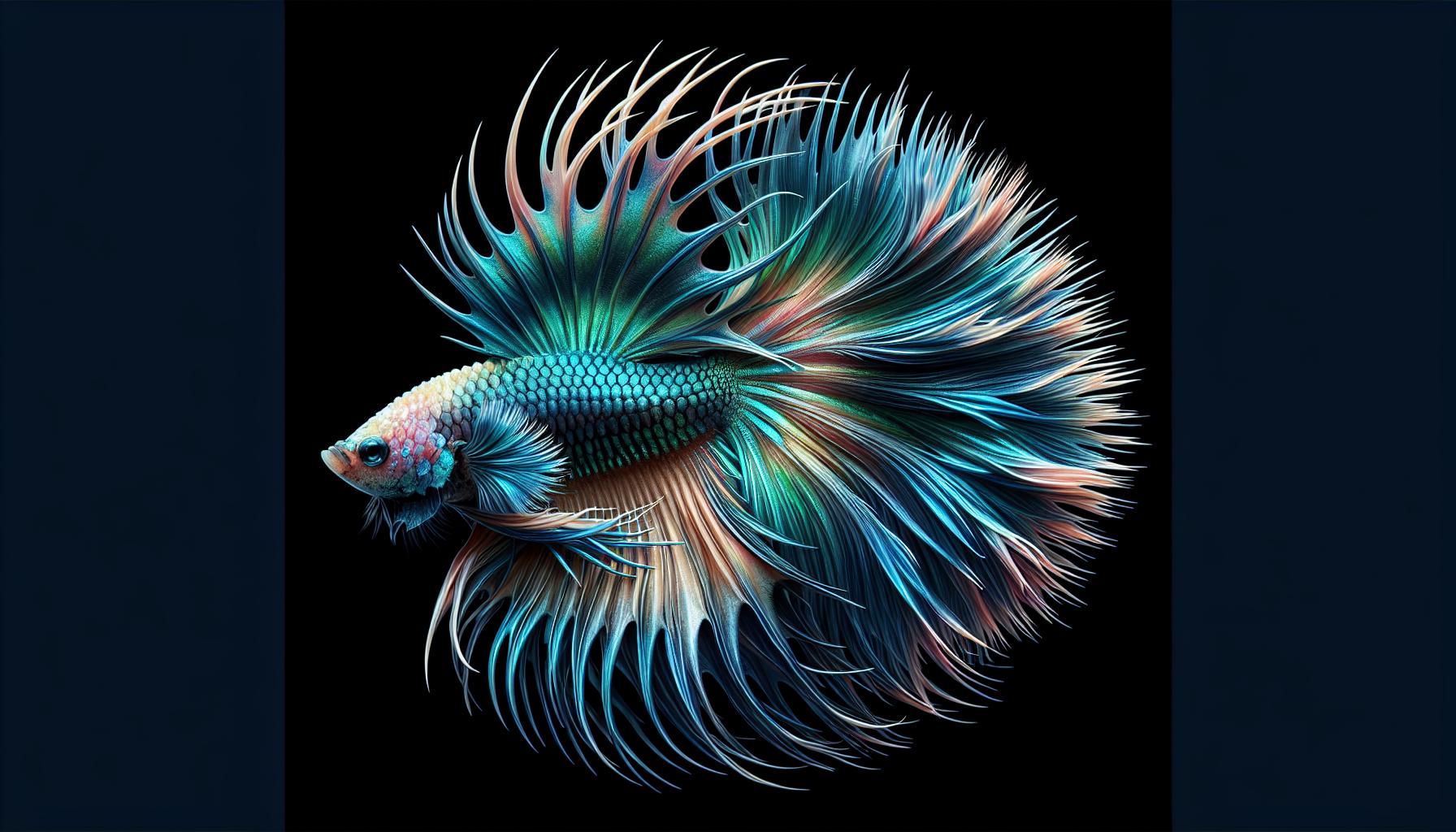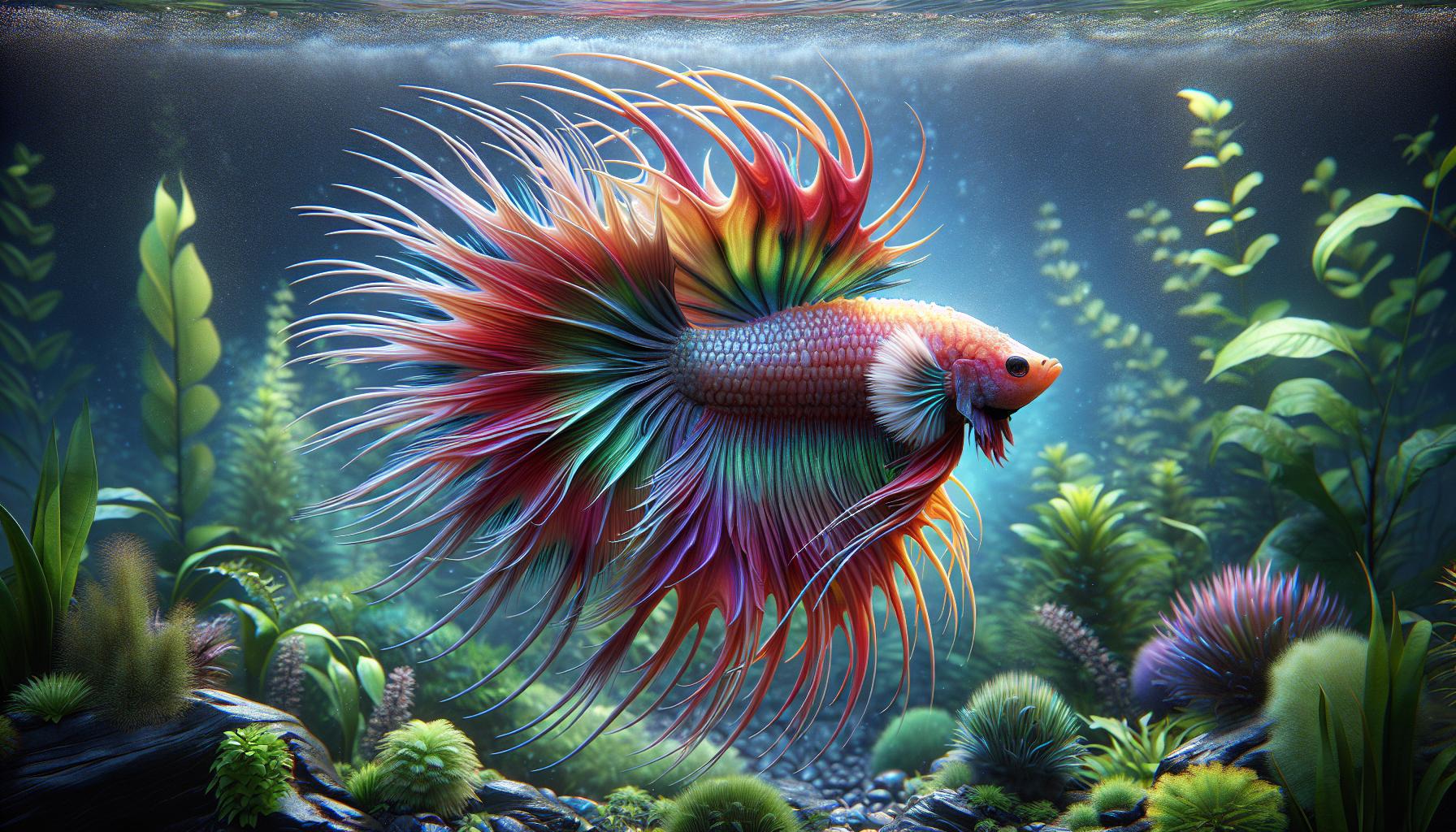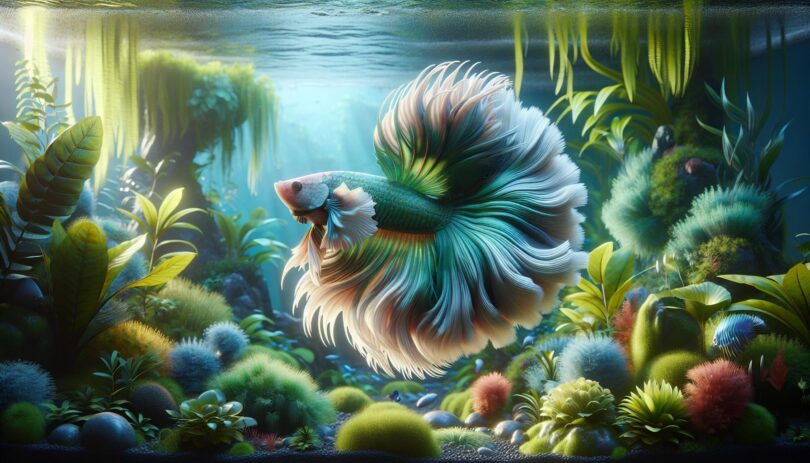Crowntail Betta fish, with their spectacular finnage resembling a royal crown, have always fascinated me. These vibrant warriors of the water world are not just a sight to behold but are also shrouded in captivating lore and care intricacies that any aquarist, novice or expert, would love to unravel.
From their aggressive demeanor to their surprisingly intricate care needs, understanding Crowntail Bettas is key to ensuring they thrive in their aquatic kingdoms. I’ve spent years marveling at their beauty and learning the best practices to keep them healthy and vibrant, which I’m eager to share with fellow enthusiasts.
Key Takeaways
- Crowntail Bettas are distinguished by their striking, crown-like finnage and vibrant colors, a result of selective breeding, primarily emerging from Indonesia in the late 1990s.
- These fish require specific care including a warm tank of at least 5 gallons, a diet rich in proteins, and regular water changes to maintain their health and color vibrancy.
- Crowntail Bettas exhibit a range of temperaments from peaceful to aggressive, depending on their environment and the presence of other fish, highlighting the need for a carefully considered aquarium setup.
- Understanding and catering to their carnivorous dietary needs with high-quality pellets and occasional live or frozen foods are critical for their wellbeing.
- Proper tank conditions, including temperature control (76°F to 82°F), clean and well-filtered water, and appropriate tank decorations and plants, mimic their natural habitat and contribute to their longevity and happiness.
- Observing and adapting to the unique behavior and needs of Crowntail Bettas can foster a rewarding companionship, emphasizing the importance of ethical and informed fishkeeping.
The History of Crowntail Betta fish

When I first became captivated by Crowntail Betta fish, I delved deep into their history to understand how they became a staple in aquariums around the world. Originating from the rice paddies and waterways of Southeast Asia, Betta splendens have been admired for centuries, but it wasn’t until the late 1990s that the Crowntail variation emerged, taking the fishkeeping community by storm.
The creation of the Crowntail Betta is attributed to Indonesian breeder Achmad Yusuf, who, through selective breeding, emphasized the striking spiky tail and fin features that distinguish this variety from others. Their unique appearance sparked immediate interest among enthusiasts and set the stage for their global popularity.
In Indonesia, Betta fish were initially bred for their aggression, leading to the unfortunate practice of fish fighting. However, as the ornamental potential of these fish was realized, the focus shifted towards beauty and form, culminating in the Crowntail’s creation. This shift not only altered the trajectory of Betta breeding but also highlighted the need for ethical treatment and appreciation of these living works of art.
The exportation of Crowntail Betta fish from Indonesia to other parts of the world began in the early 2000s. Since then, their appeal has only grown, with hobbyists and breeders alike marveling at the vast array of colors and patterns these fish can exhibit. As demand increased, so did the efforts to breed them in other countries, which helped to preserve the genetic diversity and health of the species.
Exploring the history of the Crowntail Betta has deepened my appreciation for them. It’s not just their aesthetic appeal that fascinates me, but also the journey they’ve been through to become the admired species they are today. Understanding their past has made me even more committed to providing them with the best possible care, ensuring their continued presence in our homes and hearts.
Characteristics of Crowntail Betta fish

When I first laid eyes on a Crowntail Betta fish, I was mesmerized by its distinct and dramatic appearance. These fish stand out in the aquarist community, and it’s essential to understand their unique characteristics to provide the best care.
Size and Shape are key factors that distinguish Crowntail Bettas. Typically, these fish can grow up to 3 inches in length. However, what really sets them apart is the dramatic flair of their tail and finnage. Their tail, dorsal, and pectoral fins have a distinct spiky appearance, reminiscent of a crown, hence their name. This appearance is the result of selective breeding, emphasizing long, spread-out fins with sharp, ray extensions.
The Color Spectrum of Crowntail Bettas is another stunning aspect. They come in a variety of colors and patterns, including vibrant hues of blue, red, orange, and even iridescent shades. Some of the most sought-after variants exhibit a marbling of colors or a combination of hues that seem to change under different light conditions.
Temperament is a crucial characteristic to understand for anyone considering adding a Crowntail Betta to their aquarium. Despite their aggressive history, many find Crowntail Bettas to be more on the curious side when cared for in a stress-free environment. They tend to display their feisty nature when confronted with their own reflection or another male Betta, a reminder of their roots in fish fighting. However, with proper tank setup and companions, they can exhibit quite a peaceful demeanor.
Recognizing that Crowntail Bettas require Specific Care ensures they lead a healthy, vibrant life. These bettas thrive in temperatures between 76°F and 82°F and need a tank that’s at least 5 gallons, with plenty of hiding spots to mimic their natural habitat.
Understanding these characteristics has deepened my appreciation for Crowntail Bettas and highlights the importance of dedicated care to maintain their health and beauty.
Setting up the Ideal Aquarium for Crowntail Betta fish
Creating the perfect habitat for Crowntail Betta fish is essential for their well-being and overall health. Through my years of experience keeping these splendid creatures, I’ve gathered some insights that might help you create an ideal aquarium for your Betta.
Firstly, tank size matters more than most beginners might think. While Bettas can survive in smaller tanks, they thrive in tanks that are at least 5 gallons in size. This size provides enough space for them to swim freely and explore. Additionally, a larger tank helps maintain water quality, which is crucial for the health of your fish.
Water conditions play a pivotal role in the health of Crowntail Bettas. These fish require warm water, with temperatures between 78 to 80°F. It’s also vital to keep the water clean and well-filtered. I recommend using a gentle filter to avoid strong water flow, as Bettas prefer calmer waters. Regular water changes are a must; removing 25% of the water weekly will help keep the environment healthy.
Decorations and Plants
When it comes to decorations, less is more. You want to create an environment that closely mimics their natural habitat. Here are a few tips:
- Avoid sharp decorations that can snag their delicate fins.
- Include soft-leaved plants, either live or silk, as Bettas love to rest on or under leaves.
- Consider adding a Betta hammock, which provides a perfect resting spot near the surface of the water.
Adding a hiding spot, like a small cave or a tunnel, can also help your Betta feel secure and reduce stress. Remember, a stressed Betta is more prone to illness.
Maintaining the right environment for Crowntail Bettas might seem daunting at first, but it’s quite manageable once you familiarize yourself with their needs. With the proper setup, you’ll create a thriving habitat that allows your Betta’s personality and beauty to shine.
Crowntail Betta fish Behavior and Temperament
Understanding the behavior and temperament of Crowntail Betta fish is crucial for any enthusiast looking to home one. These vibrant creatures display a fascinating range of actions and moods, from peaceful to territorial. I’ve closely observed my own Bettas and compiled insights to share with you.
Firstly, Crowntail Bettas are solitary by nature. They thrive best when kept alone as males particularly can become aggressive towards each other, leading to stress and physical harm. This aggression isn’t limited to other Bettas; they might not fare well with other species of fish either, especially those with long, flowing fins that resemble a rival Betta’s.
However, it’s not all about aggression. Crowntail Bettas have a curious side, often seen exploring their tank, flaring their gills at reflections, or even recognizing their caregivers. I’ve noticed mine reacting to my presence, swimming eagerly to the glass when I approach. This level of interaction adds a unique personal touch to owning a Crowntail Betta.
Their sleep patterns are also a point of interest. Like us, Bettas need rest and will often seek a cozy spot among plants or decorations to nap. This is why providing hiding spots and a comfortable environment is non-negotiable. They prefer low light conditions for sleeping, which mimics their natural habitat’s dusk or dawn.
Moreover, when it comes to feeding, Crowntail Bettas are mostly carnivorous. They enjoy a diet rich in proteins, often favoring live or frozen foods over flakes or pellets. Observing their feeding habits can be quite engaging, as they’re known to leap for food, showcasing their agile nature.
To sum up, the behavior and temperament of Crowntail Bettas are as varied as their colors. While they demand specific care and attention to thrive, especially regarding tank mates and environment, the reward is a beautifully interactive and spirited companion.
Feeding and Care for Crowntail Betta fish

When it comes to providing the best for my Crowntail Betta, I’ve found that understanding their dietary needs is crucial. Crowntail Bettas are carnivorous, thriving on a diet that closely mimics their natural intake. I typically feed mine a combination of high-quality pellet food, designed specifically for Bettas, and live or frozen foods such as bloodworms, brine shrimp, and daphnia. It’s vitally important to ensure the food is small enough for them to eat and to vary their diet to prevent nutritional deficiencies.
Here’s a quick guide to what I feed my Crowntail Betta:
- High-quality Betta pellets: Once daily
- Live or frozen foods: 2-3 times per week
Remember, overfeeding can lead to health issues like bloating and water pollution. I always follow the rule of thumb that they should eat their fill in about two minutes and remove any uneaten food promptly.
Caring for a Crowntail Betta extends beyond their diet. These fish require a warm, clean environment to thrive. I keep my Betta’s tank at a steady temperature of 78 to 80 degrees Fahrenheit, as fluctuations can stress them out. The tank water needs regular testing and partial changes to keep ammonia and nitrite levels in check. Creating a stimulating environment with plants and hiding spots can mimic their natural habitat and support their well-being. I’ve noticed that when my Betta has plenty of space to explore and places to rest, he’s more active and shows more vibrant colors.
Monitoring your Crowntail Betta for signs of stress or illness is also key. Their vibrant fins can lose color or become clamped when they’re not feeling well. Early detection and treatment of any health issues can make a significant difference in their quality of life.
Maintaining the right balance in feeding and care ensures my Crowntail Betta not only survives but thrives. It’s a commitment, but the vibrant colors and dynamic personality of these fish make it all worth it.
Conclusion
Caring for Crowntail Bettas isn’t just about admiring their beauty; it’s about understanding their unique needs and creating a nurturing environment for them. I’ve shared insights on their dietary requirements and the significance of a clean, warm habitat. Remember, a happy betta is one that’s well-fed but not overfed, and lives in water that’s just right. By following the guidelines I’ve laid out, you’ll ensure your Crowntail Betta thrives, bringing joy and color to your aquarium. It’s all about balance and attention to detail. Happy fishkeeping!
Frequently Asked Questions
What do Crowntail Betta fish eat?
Crowntail Bettas thrive on a varied diet, combining high-quality pellet food with live or frozen foods such as brine shrimp and bloodworms. This mix ensures they receive all the necessary nutrients.
How often should I feed my Crowntail Betta fish?
Feed your Crowntail Betta small amounts once or twice a day, ensuring they can consume the food within a couple of minutes. It’s crucial to avoid overfeeding to prevent health issues.
What are the care requirements for Crowntail Betta fish?
Caring for Crowntail Bettas involves maintaining a warm aquarium (around 78-80°F), regular water changes to keep the environment clean, and testing the water for proper pH and ammonia levels. Adding plants and hiding spots creates a stimulating environment for them.
How do I know if my Crowntail Betta is stressed or sick?
Signs of stress or illness in Crowntail Bettas include faded colors, lethargy, loss of appetite, and abnormal swimming patterns. Early detection and treatment are crucial for their recovery.
Why is it important to maintain a balanced feeding and care regimen for Crowntail Bettas?
Balancing the feeding and care of Crowntail Bettas ensures they receive the necessary nutrients without overfeeding and live in a clean, appropriate environment. This promotes their well-being, reducing stress and susceptibility to illness.

